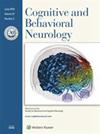Changes in Cognitive Functioning After Surgical Resection of Language-related, Eloquent-area, High-grade Gliomas Under Awake Craniotomy
IF 1.7
4区 医学
Q4 BEHAVIORAL SCIENCES
引用次数: 1
Abstract
Background: Dominant-hemisphere tumors, especially gliomas, as infiltrative tumors, frequently affect cognitive functioning. Establishing a balance between extensive resection, which is proven to result in longer survival, and less extensive resection, in order to maintain more cognitive abilities, is challenging. Objective: To evaluate changes in cognitive functioning before and after surgical resection of language-related, eloquent-area, high-grade gliomas under awake craniotomy. Method: We provided individuals with newly diagnosed high-grade gliomas of the language-related eloquent areas with the same standard of care, including surgical resection of the glioma using intraoperative sensory-motor and cognitive mapping under awake craniotomy, and the same protocol for chemoradiotherapy. Cognitive functioning was assessed using Addenbrooke’s Cognitive Examination—Revised (ACE–R) at four time points (preoperatively, early after surgery, and 3 and 6 months postoperatively). Results: The preoperative evaluation revealed a range of cognitive impairments in 70.7% of the individuals, affecting all of the cognitive subdomains (mostly attention and visuospatial abilities). Overall cognitive functioning (ie, ACE–R score) dropped by 13.5% (P = 0.169) early postoperatively. At the 3-month evaluation, an average of 15.3% (P = 0.182) recovery in cognitive functioning was observed (mostly in verbal fluency: 39.1%). This recovery improved further, reaching 29% (P < 0.001) at the 6-month evaluation. The greatest improvement occurred in verbal fluency: 68.8%, P = 0.001. Conclusion: Extensive resection of eloquent-area gliomas with the aid of modern neuroimaging and neuromonitoring techniques under awake craniotomy is possible without significant long-term cognitive sequela.清醒开颅手术切除语言相关、雄辩区、高级别胶质瘤后认知功能的变化
背景:优势半球肿瘤,尤其是胶质瘤,作为浸润性肿瘤,经常影响认知功能。在广泛切除(已被证明可延长生存期)和较少广泛切除(以维持更多认知能力)之间建立平衡是一项挑战。目的:探讨清醒开颅术下语言相关、口才区、高级别胶质瘤切除术前后认知功能的变化。方法:我们为新诊断的语言相关雄辩区高级别胶质瘤患者提供相同的护理标准,包括在清醒开颅下使用术中感觉-运动和认知映射手术切除胶质瘤,以及相同的放化疗方案。在四个时间点(术前、术后早期、术后3个月和6个月)使用Addenbrooke 's Cognitive assessment - revised (ACE-R)评估认知功能。结果:术前评估显示70.7%的个体存在一系列认知障碍,影响所有认知子域(主要是注意力和视觉空间能力)。术后早期整体认知功能(即ACE-R评分)下降13.5% (P = 0.169)。在3个月的评估中,平均15.3% (P = 0.182)的认知功能恢复(主要是语言流畅性:39.1%)。在6个月的评估中,这种恢复进一步改善,达到29% (P < 0.001)。最大的改善发生在语言流畅性上:68.8%,P = 0.001。结论:在清醒开颅下,借助现代神经影像学和神经监测技术广泛切除雄辩区胶质瘤是可行的,且无明显的长期认知后遗症。
本文章由计算机程序翻译,如有差异,请以英文原文为准。
求助全文
约1分钟内获得全文
求助全文
来源期刊
CiteScore
2.40
自引率
7.10%
发文量
68
审稿时长
>12 weeks
期刊介绍:
Cognitive and Behavioral Neurology (CBN) is a forum for advances in the neurologic understanding and possible treatment of human disorders that affect thinking, learning, memory, communication, and behavior. As an incubator for innovations in these fields, CBN helps transform theory into practice. The journal serves clinical research, patient care, education, and professional advancement.
The journal welcomes contributions from neurology, cognitive neuroscience, neuropsychology, neuropsychiatry, and other relevant fields. The editors particularly encourage review articles (including reviews of clinical practice), experimental and observational case reports, instructional articles for interested students and professionals in other fields, and innovative articles that do not fit neatly into any category. Also welcome are therapeutic trials and other experimental and observational studies, brief reports, first-person accounts of neurologic experiences, position papers, hypotheses, opinion papers, commentaries, historical perspectives, and book reviews.

 求助内容:
求助内容: 应助结果提醒方式:
应助结果提醒方式:


